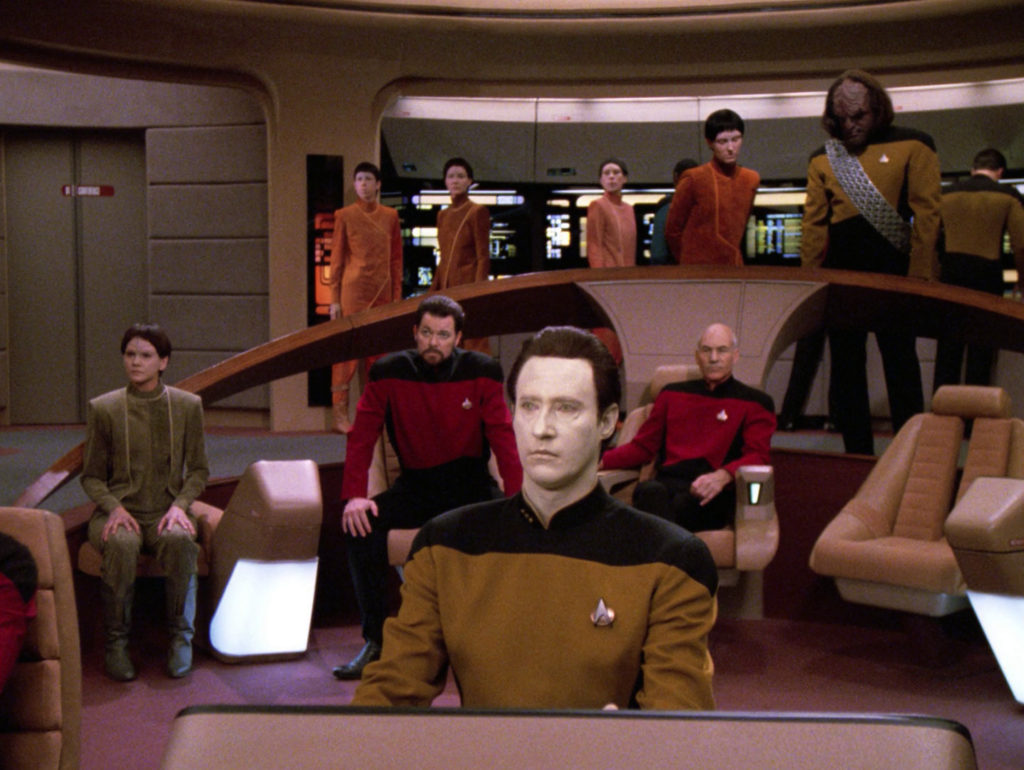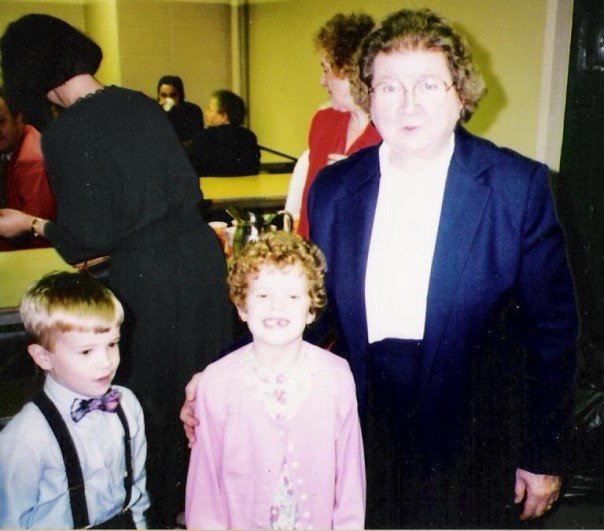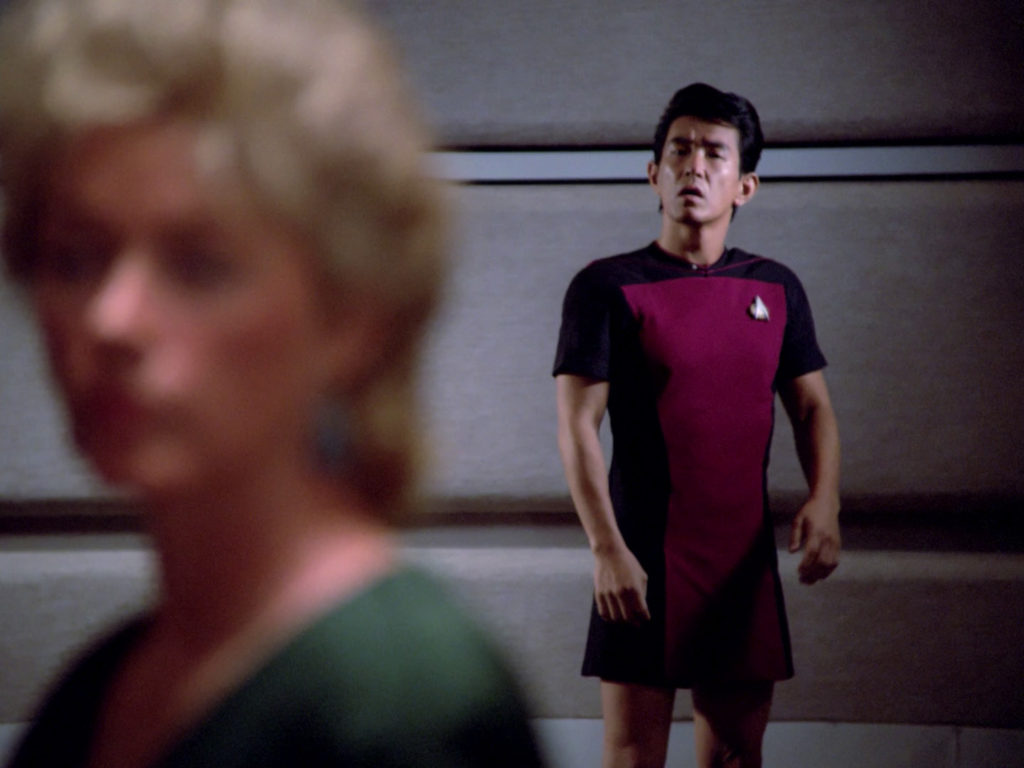It’s not easy being a queer Star Trek fan. The franchise has been praised for its diverse representation but hasn’t had a recurring on-screen queer character in 50 years – they’ve all been portrayed as cisgendered and heterosexual.* Since Star Trek is set mostly in the 24th century, the cop-out excuse that creators have used for years is that homosexualty is a non-issue in the future. When Simon Pegg and John Cho announced that Kelvin Timeline Sulu was gay in Star Trek Beyond, it was painful to see George Takei loudly disagree with the decision, and fandom cry out that the queer agenda was being shoved down their throats. While I am anxious for Star Trek: Discovery and its promised gay character, the history of queer erasure in Star Trek, and fandom’s obliviousness to this problem is very painful.
“The Outcast” from The Next Generation’s fifth season is an episode where queer representation was attempted, but the creators used an alien of the week allegory instead and it failed, in multiple ways.

Four J’naii stand in the upper bridge, while Soren sits on Riker’s left.
Right from the opening Captain’s Log we’re off on the wrong foot, as Picard describes the J’naii aliens as an “androgynous race.” There are a few J’naii on the bridge in the opening scene, wearing their hair identically, all played by female actors. Viewers can easily assume that women wearing their hair in a bowl cut equals androgynous.
According to Memory Alpha, this episode was filmed in January and aired in March 1992. I was three years old at the time, and barely remember the early 90s. What I do remember, thanks to a Kindergarten graduation photo, is that I had my hair short and super curly. After being mistaken for a boy at a science museum during school vacation, I started keeping my hair long enough to be pulled back in a ponytail. I essentially made the same assumption as a four or five year old, that hair length determines gender.

The author (middle), graduating from Kindergarten
In the Season 1 TNG episode “Where No One Has Gone Before” there is a man in a skant uniform, with short ankle boots instead of calf ones. Despite him only showing up in the background, it is nice knowing there were men on board the Enterprise who chose the skant over pants. Unfortunately we don’t see many skants after the main cast get new uniform designs in season 3. But it speaks to the power of a background character. Fans will pick up on it. If even one of the J’naii was portrayed by a male actor then some of this response would be mitigated!

The men’s skant reappears in “Where No One Has Gone Before”
There are specific lines in “The Outcast” that feel problematic. When Soren is curious and asking Riker and Dr. Crusher about relationships and the differences between men and women, the replies assume heterosexual and cisgender as the default. Riker tells Soren in the shuttle: “For humans, the sexual act brings a closeness and intimacy. It can be a very pleasurable experience.”
In the next scene, Dr. Crusher assures Soren that men “like to pretend they’re not doing anything to attract a woman, even when it’s the most important thing on their minds.” Neither Riker nor Dr. Crusher are fully aware of Soren’s feelings and identity at this point in the episode, but it would have been nice for them to not give a blanket response that assumes defaults. It feels painful to be excluded from the 24th century.
The J’naii’s reaction to gender identity and how it must be cured with “psychotectic” treatments is akin to our “conversion therapy.” The tribunal scene where Soren is sentenced to this “cure” can feel heavy-handed, especially the J’naii leader Noor’s line: “You must think that we are a cruel, repressive people. Nothing could be further from the truth.” Viewers not familiar with conversion therapy may agree that Soren is sick and see the J’naii treatments as an act of compassion.
At least Riker’s character is a saving grace in this episode. In a reversal of his character trope, he is not the one to express attraction to Soren first. I do wish he had known about the singular “they” as a gender-neutral pronoun, but he expresses a willingness to learn about Soren, and even checks in with Deanna Troi because he is worried their relationship will change.
That never seems to happen when Riker meets the alien of the week, so it stood out to me, signifying this isn’t a “fling” to him. He was willing to put his career on the line to protect Soren. He was willing to lie for Soren. He was even willing to break the Prime Directive, after being told there was nothing they could do officially.
Should Rick Berman have pushed Jeri Taylor to go further and acknowledge to Soren that maybe, not everyone who is a human feels and thinks the same way? Maybe there should have been a background character equivalent, a throw away line like: “My relative on Earth knows a really happy gay couple….”
Or maybe that was simply too much for the writing team to consider in December, 1991. I know I am coming at it with 25 years of hindsight. But when I watched this episode back in 2010, I had just come out as queer and Soren’s speech at her tribunal moved me. Now, I don’t think she could ever be “cured” regardless of what the J’naii hoped to achieve with their treatments. She’d just go back into hiding and be miserable. And judging by his pained look in the last close up before credits, Riker knows it too.
*An argument could be made that Dax was neither cisgender nor heterosexual, an issue explored in the Women at Warp episode about the DS9 episode “Rejoined” and one that could be addressed in future blog posts.
George Takei was on The Howard Stern show the other day and they were talking about him speaking out about Sulu being played as homosexual by John Cho and why he spoke out about it. He said that his issue was Mr. Roddenberry had created and established the characters a certain way and they should be viewed that way regardless of his personal opinion. He said he’d definitely be in favor of a gay character in Trek – just a newly established one rather than changing one that existed.
He may have made this statement many times before, but it’s the first time I’d heard him make it quite that succinctly.
I’m not Trekker and really don’t follow it – but from your perspective is this saving face or was that his stance all along?
“Blood and Fire” was released as a TOS episode in the the Star Trek Phase II fan-project.
Teaser: https://www.youtube.com/watch?v=7lyjpadAV9Y
Part I: https://www.youtube.com/watch?v=QtifyhPScCw
Part II: https://www.youtube.com/watch?v=c-LbNN-7Pbc
It’s definitely worth a watch.
There were a few writers working on TNG that attempted to tackle issues that were deemed controversial. For instance, David Gerrold, a star trek writer who happened to be gay, wrote a script, “Blood and Fire” that dealt with a blood donorship. The script was written at the height of the AIDS epidemic and the fear of donating blood was sweeping our country. The script also contained one passing reference (one sentence) by Commander Riker to a gay couple: How long have you two been together?
What happened you may ask.
All hell broke loose, memos and counter memos went flying, and the script got shelved. David Gerrold, left the TNG at the end of season one, and never looked back. The moral of this story: Star Trek writers want to tell great stories about many issues that we feel strongly about, unfortunately, the guys that sign the checks are only interested in ratings and advertising revenues.
Gene said at the beginning that there would be no gay people in his universe. They had to wait for him to die to do anything with Dax.
I did get a chance to ask George Takei back in 2013 when he came to Boston for Creation’s con/Boston Pride. The gist of his story was that he asked Gene during the production of season 3(?) and Gene said something along the lines of “I want to, but we’re already in danger of being cancelled.” And George was in the closet for a long time so the issue wasn’t pushed.